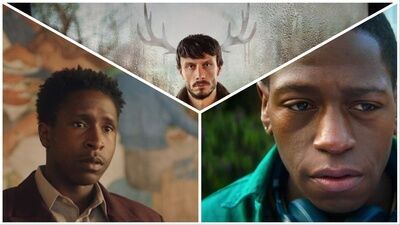When a man stripped him of his strength and identity of manhood, he became powerless in a hurtful and extremely damaging situation. This tragic event can be even heavier in the presence of other men, leading the victimized to wonder what other men will think of them? Time and time again men bury these hurt emotions, performing masculinity like a clown with face paint dancing among a crowd of performers in the same makeup.
This fear of perception also manifested when Gadd’s character falls in love with Nava Mau’s character, Teri, a trans woman he met on a dating app. Instead of proclaiming his love from the rooftops, he hides it, scared of what other men might think of his sexuality. However, something unique about “Baby Reindeer” is that Gadd doesn’t allow our protagonist to wallow in his perceived masculinity. He ebbs and flows between his trauma and change. He opens up to Teri about Martha and even takes her out in public to the bar where he worked, where people knew him. Although Gadd’s character doesn’t end the series with a tidy life wrapped up with a bow, we see him continue to try. Growth isn’t linear, and it was wonderful to see that explored on screen.
Thankfully, “Baby Reindeer” doesn’t exist in a vacuum. It isn’t the only exploration of masculinity and vulnerability in the media, as we’ve seen an increase in POC and BIPOC stories being developed into the complex narratives they are. White men aren’t the only ones allowed to be vulnerable. For example, Barry Jenkins, renowned for his ability to humanize his leading men, was a trailblazer in how audiences saw black men with his directorial hit “Moonlight.” Jenkins presented a nuanced view of black masculinity that differed from the hypermasculine and womanizing portrayals of the 70s, 80s, 90s, and 00s. He explored how fear and shame can lead men to internalize their emotions, locking them up and throwing away the key. Trevante Rhodes’s character, Black, is the epitome of performing masculinity. Like Gadd, Black’s outward appearance did not reflect who he was internally, and only by reconnecting with his former love, Kevin, was he truly liberated.
Freedom, however, isn’t confined to romantic intimacy; it also manifests in platonic closeness. When we look at films like Joe Talbot’s “The Last Black Man in San Francisco,” we see what masculinity can be between two black men when they support each other. The film follows Jimmie and his best friend, portrayed by Jonathan Majors, as they strive to reclaim Jimmie’s family home in a rapidly gentrifying San Francisco. An image that always comes to mind when thinking about this film is the picture of Jimmie Fails, Jonathan Majors, and Danny Glover embraced in a warm and inviting hug. It’s a hug symbolic of what every young black boy needed in his life, but never received.

